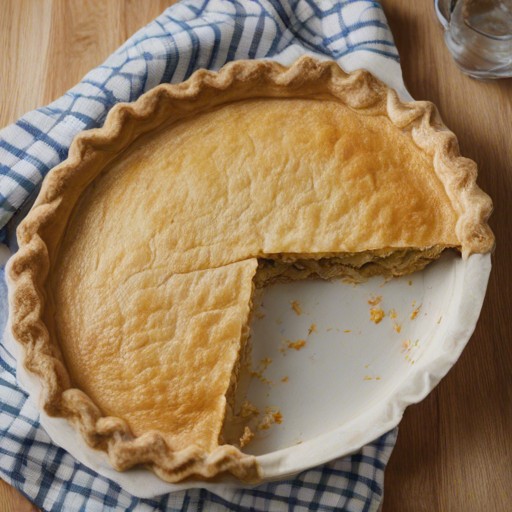Mastering Shortcrust Pastry (Pâte Brisée): Your Guide to Perfect Pie Crusts
Whether you’re a seasoned baker or just starting out, mastering the art of shortcrust pastry, also known as Pâte Brisée, is a fundamental skill in the world of baking. Shortcrust pastry is incredibly versatile and forms the base for many delicious desserts and savory dishes, including pies, tarts, quiches, and more. In this comprehensive guide, we’ll delve into everything you need to know about making perfect shortcrust pastry from scratch. From the ingredients and equipment you’ll need to step-by-step instructions, cook notes, variations, and even keto and low-carb options, we’ve got you covered. Let’s roll up our sleeves and get ready to create flaky, buttery perfection!
Frequently Asked Questions (FAQs)
Q: What is shortcrust pastry? A: Shortcrust pastry, or Pâte Brisée in French, is a type of pastry dough that is commonly used as the base for pies, tarts, and quiches. It is characterized by its tender, crumbly texture and rich, buttery flavor.
Q: Can I make shortcrust pastry ahead of time? A: Yes, you can prepare shortcrust pastry ahead of time and store it in the refrigerator for up to 2 days or freeze it for longer storage. This is particularly convenient if you’re planning to bake pies or tarts in advance.
Q: What is the difference between shortcrust pastry and puff pastry? A: While both shortcrust pastry and puff pastry are types of dough used in baking, they have different textures and uses. Shortcrust pastry is rich and buttery with a tender, crumbly texture, making it ideal for pies and tarts. Puff pastry, on the other hand, is made by repeatedly folding and rolling layers of dough and butter, resulting in a flaky, airy texture. It is commonly used for pastries such as croissants and palmiers.
Ingredients
Main Ingredients:
- 1 cup all-purpose flour
- 1/2 teaspoon kosher salt
Additional Ingredients:
- 1/2 cup unsalted butter, cold and cubed
- 3 tablespoons ice water
Instructions
Step 1: Prepare the Ingredients
- Start by measuring out the flour and salt. Cube the cold butter and place it back in the refrigerator to keep it chilled.
Step 2: Cut in the Butter
- In a large mixing bowl, add the flour and salt. Add the cold, cubed butter to the bowl.
Step 3: Incorporate the Butter
- Using a pastry cutter or your fingertips, work the butter into the flour mixture until it resembles coarse crumbs. The butter should be evenly distributed throughout the flour.
Step 4: Add Ice Water
- Gradually add the ice water to the flour mixture, one tablespoon at a time, tossing with a fork or your hands until the dough begins to come together. Be careful not to overwork the dough.
Step 5: Form the Dough
- Once the dough starts to come together, gently knead it a few times in the bowl until it forms a cohesive ball. Be careful not to over-knead, as this can result in a tough pastry crust.
Step 6: Chill the Dough
- Flatten the dough into a disc, wrap it tightly in plastic wrap, and refrigerate it for at least 30 minutes to allow the butter to firm up and the gluten to relax.
Step 7: Roll Out the Pastry
- Once chilled, remove the dough from the refrigerator and let it sit at room temperature for a few minutes to soften slightly. On a lightly floured surface, roll out the dough into a circle of your desired thickness.
Step 8: Use as Desired
- Your shortcrust pastry is now ready to be used in your favorite pie or tart recipe. Follow the instructions for baking according to your specific recipe.
Cook Notes and Variations
- Blind Baking: If your recipe calls for a pre-baked pie crust (also known as blind baking), prick the bottom of the pastry crust with a fork, line it with parchment paper, and fill it with pie weights or dried beans to prevent it from puffing up during baking. Bake it in a preheated oven according to your recipe’s instructions until lightly golden brown.
- Sweet Shortcrust Pastry: To make a sweet version of shortcrust pastry, simply add a tablespoon of granulated sugar to the flour mixture before cutting in the butter. This is perfect for desserts like fruit pies and tarts.
- Flavor Variations: Experiment with different flavor variations by adding spices such as cinnamon, nutmeg, or cardamom to the flour mixture for a unique twist on traditional shortcrust pastry.
Keto Versions and Low-Carb Options
- Almond Flour Variation: For a keto-friendly or low-carb version of shortcrust pastry, substitute almond flour for the all-purpose flour in equal measure. You may need to adjust the amount of butter slightly, as almond flour tends to absorb more moisture.
- Coconut Flour Variation: Another option is to use coconut flour instead of all-purpose flour. Keep in mind that coconut flour is highly absorbent, so you’ll need to use less of it and increase the amount of liquid (such as water or egg) in the dough.
Mastering the art of making shortcrust pastry opens up a world of culinary possibilities, allowing you to create a wide range of delicious sweet and savory dishes. With just a few simple ingredients and some basic techniques, you can whip up flaky, buttery pastry crusts that will elevate your pies, tarts, and quiches to new heights. Whether you’re a novice baker or a seasoned pro, this versatile pastry dough is sure to become a staple in your kitchen. So roll up your sleeves, dust off your rolling pin, and get ready to impress your family and friends with your homemade shortcrust pastry creations!

